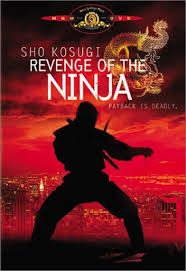
REVENGE OF THE NINJA
US, 1983, 80 minutes, Colour.
Sho Kosugi, Keith Vitali.
Directed by Sam Firstenberg.
Revenge of the Ninja was produced by the Canon Group, Yoram Globus and Menahem Golan. It is a sequel to Enter the Ninja, with Franco Nero, directed by Golan himself.
This film is a definite improvement on the original. It is stylishly photographed, the Ninja and martial arts fights imaginatively if fantastically choreographed and there is some characterisation and theme treatment. The contrasts between American and Japanese society are highlighted - modern western big business ways and traditional Japanese ways. The question of adaptation of the Japanese to the American way of life is also to the point. However, the emphasis is on the action and the heroism of the lead.
The film is set in Salt Lake City and the locations are very well used. There is a rousing score. Above average entertainment of its kind -though it does have strong stylised violence.
1. The popularity of martial arts films? Martial arts and American crime? International crime? The portrayal of violence in the '70s and the '80s? Japanese codes? American codes? Comparisons and contrasts?
2. The opening in Japan with its atmosphere: landscapes, costumes, decor? The transition to the United States? Salt Lake City? Authentic atmosphere? Colour photography? Editing and pace? The special effects e.g. the Japanese dolls? The rousing score?
3. The popularity of the martial arts in the West? Japan and the United States? The two cultures, the traditions? Comparisons, contrasts?
4. The background of the Ninja: good and bad, the opening massacre, audience expectations, the effect of the massacre on the Japanese family, the move to the United States, the exercise of Ninja martial arts in Salt Lake City? The irony of the American living in Japan and absorbing the Ninja tradition, using and exploiting it and Japanese heroes? The violence of the Ninja tradition, weaponry, codes? The choreography of the fights?
5. The plot and its familiarity from police stories on television? The massacre in Japan, the opening of the gallery in Salt Lake City, Japanese lifestyle in the United States, peace? The girl as a spy? The villain and his henchmen? The cover of the gallery fro drug-smuggling? The power of the Mafia and the clashes? The role of the police? The kidnap of the little boy? The fights? Conventions enjoyable for audiences?
6. Cho as hero? In himself, Japan, the death of his wife? His devotion to his mother - and his grief at her violent death? His love for his boy? Teaching him the martial arts? Kathy as his assistant? His work, retiring from Ninja arts? The dolls? The stealing of the dolls and the vigorous chase, the fights, dragged along the ground, into the van etc.? His being used by the villain? His scaling the wall of the building, the confrontation with the Mafia, the fight to the death with the villain? A typical hero? Humanity, skills?
7. The contrast with the villain, seeming friendliness, using Cho, the massacre of his family, the death of his mother? The boy witnessing this? Cruelty? The Ninja disguise and the mask? His murdering of the Mafia? His brutality towards Kathy? His henchmen - fat and brutal, torturing? The final fight and his death?
8. Kathy as the conventional heroine, spy, hypnotised by the villain, kidnapping the boy, redeeming herself?
9. The background of the Mafia - presented, caricatured? The hoods? The murders - the nephew and his girlfriend? The victims, the slaughter in the building? The Mafia chief dying?
10. The sketch of the police, their investigations, the martial arts policeman - and the pathos of his death?
11. The skill in the choreography of the martial arts fight? The emotional response of the audience? Admiration of skills? Response to the range of weaponry and its deadly effects - the man injured in the city centre through the eye, falling into the pool etc.?
12. The reasons for the popularity of this kind of film in the '70s and the 180s?